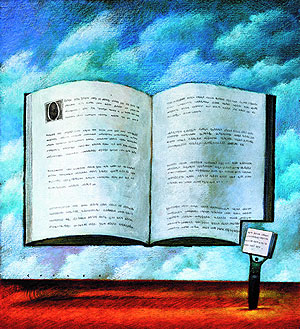|  The
Writing on the Wall The
Writing on the Wall
Oberlin's Creative Writing Program is tough
and intimidating, so why are students clamoring to get in?
by Doug Diesenhaus '02
About 60 of us sat in Professor Dan Chaon's
introductory fiction writing class,
alternately feeling excited and petrified. One-by-one our short
stories--magnified ten fold--were being projected onto the screen
in King Building's cavernous lecture hall.
We followed along as Chaon read aloud the current
piece. In this case, the author's name had been blocked out,
allowing him or her to remain anonymous during the ensuing class
discussion. We weren't always this lucky; in other, more intimate
creative writing workshops, we often endured face-to-face evaluations
of our stories and poetry.
Creative Writing 110 is among the largest of Oberlin's writing classes,
consistently enrolling 60 or more students. In most such classes
and workshops, students are given one or two assignments each week;
several are then presented to the class for feedback and evaluation.
Each of us, when our moment came, hoped for the same things: that
our peers would find value in our writing, critique it constructively,
or, at the very least, not hate it. College writing courses throughout
the country use this basic workshop style; it allows students to
interact with established poets and prose writers while learning
from the comments and writing of fellow classmates.
The process is intimidating, and we weren't the first students to
approach it with trepidation. "Workshops, as they are perhaps
meant to be, are simultaneously wonderful and terrifying,"
says Visiting Assistant Professor Michael Byers '91, author of the
short story collection The Coast of Good Intentions. "Being
present while your story is discussed is like hearing your relatives
talk about your corpse while you listen from a corner near the ceiling."
Although overwhelming at times, the pressure proves to be of
great benefit to students throughout the semester. "Having
to bring work in, present it in public, and stand behind it
is a marvelous goad to producing the best possible work,"
Byers says. "In very few places are your efforts so baldly
and explicitly judged."
Sophomore Ashly Emmer agrees. "The most nerve-racking part
is being judged," she says, "but overall, the process
is more rewarding than praise or criticism from a teacher because
you get to hear honest remarks from students who are in the
same boat as you."
Page 1 |
2 | 3 of
The Writing on the Wall
|


